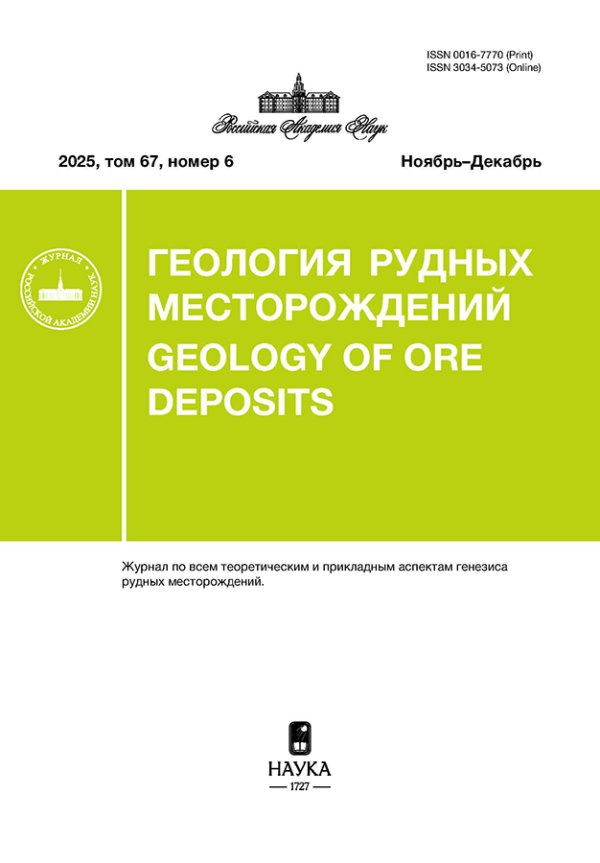Vol 65, No 6 (2023)
Articles
Occurrence of Carbonated Groundwater and Hydrocarbons at the Uranium Deposits of the Khiagda Ore Field (Republic of Buryatia)
Abstract
A generalization of unpublished and published data since 1985 on biogeochemical, hydrogeochemical, geochemical, mineralogical studies and soil geochemistry at uranium deposits of the Khiagda ore field in the Vitim uranium ore district made it possible to reveal a genetic relation of deep cold carbonated hydrocarbonate–magnesium groundwater containing dissolved hydrocarbons (HCs) to uranium mineralization and ore preservation. The through penetration of epigenetic HCs was traced from the disintegration zone of basement granitoids through overlying sedimentary ore-bearing and volcanosedimentary rocks up to overlying fractured basalts. The assemblage of clarified rocks–HCs–siderites–uranium phosphates U(IV) was commonly found. Carbonated hydrocarbonate–magnesium groundwater and anomalous HC contents in soils can be additional criteria for identifying the Vitim-type uranium deposits in the Trans-Baikal region.
 495-508
495-508


Evolution of Rare-Metal Li–F Granite Melts in Sources of Ore-Magmatic Systems of Tigrinoe and Zabytoe Sn–W deposits (Central Sikhote-Alin, Primorye)
Abstract
The present paper considers petrographic and geochemical features of rocks of the Tigrinoe and Zabytoe stocks, provides their mineral composition, the results of the detailed study of micas and mineral-forming inclusions in quartz. It is shown that the development of ore-magmatic systems (OMSs) of the Zabytoe and Tigrinoe deposits is associated with the same rare-metal Li–F melts. It is confirmed that granitoids of the Tigrinoe stock can be considered as more differentiated analogs of granitoids of the Zabytoe stock. New data concerning the differences in the history of the magmatic stage of development of the OMSs of these deposits are presented. The evolution of melts of both deposits took place at high fluid pressure. Differences in the scale of ore mineralization of the two RMSs under consideration could be due to different fluid regime of magmatic sources evolution and more significant participation of transmagmatic fluid flows in the development of the Tigrinoe OMS.
 509-527
509-527


Mineralogy and Conditions of Formation Genesis of Aggregates of Natural and Sulfide Minerals of the Poldnevskoe Demantoid Deposit (Middle Urals)
Abstract
Polymineral aggregates of rounded shapes (“nodules”) composed of native and sulfide minerals of Cu, Ni, Fe, Ag, and other elements from vein magnetite–calcite–chrysotile rocks with jewelry demantoid in the Korkodinskoe hypermafic massif are described. A common feature of the six identified types of native sulfide nodules, composed of native copper, heazlewoodite, pentlandite, cuprite, and other native sulfide minerals, is their spheroidal shape, which makes them similar to individual grains of other gangue minerals (calcite, magnetite, etc.). In heazlewoodite–pentlandite nodules, specific symplectites of mercuric silver and nickel copper in heazlewoodite, as well as awaruite in Co–pentlandite, were found. The matching set of ore minerals in the host serpentinite vein mass (native copper, mercuric silver, heazlewoodite, pentlandite, awaruite) and nodules from the vein material indicates their genetic connection and the conjugation of demantoid mineralization with the evolving processes of serpentinization. It was established that the nodules formed at temperatures below 380°C under reducing conditions at very low sulfur fugacity values (10–17–10–27 bar) and oxygen (10–30 bar at 200°C to 10–21 bar at 350°C). For heazlewoodite–pentlandite nodules, such conditions persisted throughout the entire time of their formation, while, for other nodules, the reducing conditions of early parageneses were replaced by oxidative conditions in late parageneses, which is recorded by the replacement of native copper with cuprite. It is assumed that the features of the morphology and structure of native sulfide nodules and the presence of symplectite intergrowths of ore minerals in them are associated with specific conditions created during the decompression of the crust-mantle mixture rising to the surface in the fault zone. The source of the metals was a deep, high-temperature fluid interacting with mafic and ultramafic rocks under reducing conditions at a low water-to-rock ratio.
 528-550
528-550


Sulfide Mineralization of Carbonate–Silicate Veins in Early Proterozoic Metabasites of North Karelia: Mineral Assemblages, Mineral Forms of Silver, and Fluid Inclusions
Abstract
The work presents the first data on sulfide mineralization in carbonate–silicate veins, which are widespread on the islands and coast of the White Sea (North Karelia), associating with Early Proterozoic metamorphosed gabbroid bodies. The veins with Fe–Cu sulfide mineralization up to ore occurrences are localized within metabasite bodies and along their contacts with host gneisses. During the study of the mineral composition of the veins, the main assemblages of sulfide minerals were identified: chalcopyrite –bornite ± chlorite ± selenides and Pb–Ag tellurides (B1); digenite–bornite ± selenides and Pb, Ag, and Pd tellurides (B2); pyrite–bornite ± chalcopyrite (B3); marcasite–pyrite–bornite–chalcopyrite (B4); and siegenite–chalcopyrite ± acanthite ± chlorargyrite. The development of sulfide associations, as well as quartz–chlorite aggregates, was related to the late stage of vein formation. Inductively coupled plasma and laser ablation mass spectrometry analyses showed that bornite from association B1 has the highest silver content (up to 675 ppm) and, in terms of Ag, Se, and Bi contents, is closest to bornite from low-temperature epithermal, skarn, and high-temperature vein deposits. In general, bornite is the main Ag carrier in the studied associations, while digenite containing up to 1000 ppm Ag, as well as discrete silver minerals (selenides, tellurides, acanthite, and chlorargyrite), occur in subordinate quantities. Fluid inclusions in quartz from sulfide associations, as well as from a sulfide-free carbonate–silicate vein, were studied by cryo- and thermometric methods. It is established that mineralization at the late stages of vein formation was related to heterogeneous CO2–H2O–NaCl metamorphic fluid. Carbon dioxide fluid inclusions were captured by vein quartz at temperature of 253–314°C and pressure of 2 ± 1 kbar. Water–salt inclusions were captured in a wider temperature range of 100–500°С. The highest temperature fluid inclusions with temperatures of homogenization >300°С are characteristic of quartz veinlets of the siegenite–chalcopyrite association with Ag sulfide and chlorargyrite.
 551-578
551-578


Scandium Ore Occurrences in the Ancient Weathering Crust in the Nakyn Kimberlite Field of Yakutia
Abstract
In the Malo-Botuobinsky, Sredne-Markhinsky, and Ygyattinsky diamond-bearing areas of the Western Yakutian kimberlite province, the prerequisites and signs of scandium deposits in ancient weathering crusts overlying Lower Paleozoic rocks and associated with zones of ancient reservoir and soil oxidation. According to X-ray fluorescence and ICP MS analyses, in the Nakyn kimberlite field of the Sredne-Markhinsky diamond-bearing region, promising ore occurrences and scandium concentration halos have been established in clay deposits of redeposited weathering crusts of the Dyakhtar Formation of Late Triassic–Early Jurassic age. They are confined to the erosional surface of Lower Paleozoic carbonate rocks and Middle Paleozoic traps, with monzonite porphyries and kimberlites cutting through them, covered on top by a sedimentary cover of Jurassic terrigenous deposits. Concentration anomalies of scandium in clays of the Dyakhtar Formation are localized mainly in deluvial clay deposits of paleowatersheds and gravitate to the intersections of tectonic disturbances. The depth of their occurrence does not exceed 100 m, which is quite favorable for the extraction of scandium by borehole in situ leaching. Concentrations of scandium were detected at one of the sites before 262 g/t in Late Triassic weathering crust, including material from a Middle Paleozoic gabbro dike, as well as overlying colluvial clays of the Dyakhtar formations with a maximum of 462 g/t.
 579-588
579-588












